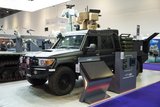Rockwell Collins successfully conducts waveform testing for Joint Tactical Radio System Ground Mobile Radios
Rockwell Collins has successfully conducted UHF SATCOM and HF waveform Functional Qualification Testing (FQT) on the Joint Tactical Radio System (JTRS) vehicular Ground Mobile Radios (GMR). This testing is conducted to ensure that the Software Communications Architecture compliant waveforms met all allocated JTRS requirements.
FQT reasonably simulates the production environment. Successfully conducting FQT verifies that the UHF SATCOM and HF waveforms will provide expected operational waveform functionality before GMR systems are fielded. The waveforms can then be used to support the Production Qualification Testing phase of the GMR program.
"We are very excited about bringing this important communications capability to the warfighter," said Bruce King, vice president and general manager of Surface Solutions for Rockwell Collins. "JTRS GMR will enable warfighters to do what they've never been able to do with a single communication device - communicate with each other seamlessly in an ad hoc network using next generation waveforms, such as WNW and SRW, while also utilizing legacy HF and UHF SATCOM capabilities."
Like all JTRS Operational Requirement Document waveforms in the 2 MHz to 2 GHz frequency range, the UHF SATCOM and HF waveforms can run in any of the GMR system's four reprogrammable Universal Transceivers.
Rockwell Collins is a member of the Boeing-led GMR team whose vehicular JTRS radio design is based on the Rockwell Collins Modular Communications Platform - a unique Software Defined Radio packaging concept which partitions hardware modules according to function at the lowest operational level. This innovative approach substantially improves mission effectiveness and simplifies testing, repair and upgrades in the field, while the design reduces total life cycle cost for platforms on the battlefield.
Source: Rockwell Collins
More from Digital Battlespace
-
![Babcock nears first customer for Nomad AI translation tool]()
Babcock nears first customer for Nomad AI translation tool
Nomad can provide militaries with real-time intelligence, saving critical time on the battlefield.
-
![AUSA 2025: Israel’s Asio Technologies to supply hundreds of improved Taurus tactical systems]()
AUSA 2025: Israel’s Asio Technologies to supply hundreds of improved Taurus tactical systems
Taurus operates alongside the Israel Defense Forces’ Orion system which supports mission management across tens of thousands of manoeuvring forces, from squad leaders to battalion commanders.
-
![AUSA 2025: Kopin pushes micro-LED plans as China moves faster]()
AUSA 2025: Kopin pushes micro-LED plans as China moves faster
The plan for the new displays follows fresh investment in Kopin’s European facilities by Theon and an order for head-up displays in fielded aircraft, with funding from the US Department of Defense.
-
![AUSA 2025: Persistent Systems to complete its largest order by year’s end]()
AUSA 2025: Persistent Systems to complete its largest order by year’s end
Persistent Systems received its largest ever single order for its MPU5 devices and other systems earlier this month and has already delivered the 50 units to the US Army’s 4th Infantry Division.
-
![Aselsan brings in dozens of companies and systems under the Steel Dome umbrella]()
Aselsan brings in dozens of companies and systems under the Steel Dome umbrella
Turkey has joined the family of countries attempting to establish a multilayered air defence system with government approval in August 2024 for the effort landed by Aselsan. Dubbed Steel Dome, the programme joins Israel’s Iron Dome, the US Golden Dome, India’s Mission Sudarshan Chakra and South Korea’s low-altitude missile defence system.
-
![DSEI 2025: MARSS unveils new agnostic multidomain C4 system]()
DSEI 2025: MARSS unveils new agnostic multidomain C4 system
MARSS’ NiDAR system has been deployed using sensors from static platforms to provide detection and protection for static sights, such as critical infrastructure, ports and military bases.




























